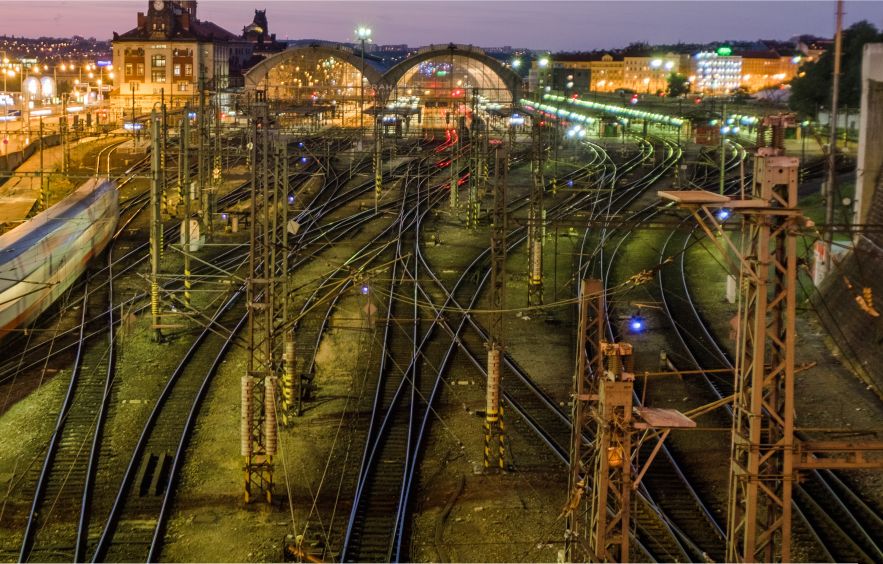Czechia rail infrastructure is on the move… Prague’s main station is getting a 7.4 billion euro makeover, which will see the construction of a new two-level rail hub, 10.6 km of fresh tunnels, and five new underground stations in the centre of the Czech capital. Meanwhile, the country’s wider ETCS rollout in January appears to have been a success, with a reported 99 per cent reliability rate.
The Czech railway infrastructure manager, Správa železnic (SZ), has presented plans for a transformative railway expansion in Prague, which will see a planned 7.4 billion euro rail investment in the capital. The Central Commission of the Ministry of Transport has signed off on a project that will significantly increase capacity at the city’s main railway hub by constructing two new tunnel routes and a state-of-the-art underground station beneath the existing Praha hlavní nádraží (Prague Main Station).
The approved design includes two intersecting tunnels, with one situated directly beneath the existing underpasses and the other at a lower level. These tunnels will be linked by escalator-equipped passageways, leading to vestibules located at Winston Churchill Square and the new departure hall of the main station.
Each tunnel will allow for up to 16 trains per hour in each direction, giving a boost to how the station’s long-distance and regional services are separated. New underground stations will be located at Karlín, Wenceslas Square, Karlovo Náměstí, and a partially buried stop at Florenc. SZ, Czechia’s state institutions, and the local Prague authorities will be working together on the implementation of the massive project.
‘Much-needed rail capacity’
The decision to move ahead follows a feasibility study that examined three main designs and two modified versions of one. One rejected option proposed two underground stations linked by a shared four-track tunnel, while another considered a single central station called Opera. However, the authorities decided instead on the current guise for the project, which will bring significant traffic relief to the Czech capital.
“This project brings much-needed rail capacity right into the city centre, creating several new strategic stops that will reduce walking distances for passengers,” said Zdeněk Hřib, First Deputy Mayor of Prague for Transport. “The strengthened railway network will also alleviate pressure on the busiest public transport routes and divert some road traffic, reducing emissions and noise levels.”
Czechia ETCS rollout hits 99% reliability
And while Prague’s railway infrastructure prepares for its biggest transformation in decades, Czechia’s national rollout of the European Train Control System (ETCS) has already made a strong start.
January 2025 marked the first full month of ETCS-exclusive operation on selected main corridors, covering more than 600 km of track. In that time, over 30,000 trains ran under ETCS supervision, collectively travelling more than two million kilometres. On average, 1,600 trains operated under ETCS daily, bringing the monthly total close to 50,000.
 The new ETCS rollout in Czechia is going well. © Ministry of Transport of the Czech Republic
The new ETCS rollout in Czechia is going well. © Ministry of Transport of the Czech Republic
Crucially, 99.1 per cent of trains completed their journeys without encountering any failures related to ETCS. Only 0.9 per cent of trains required a preventive safety response, primarily due to ‘trips’ that resulted in automatic train stops. These incidents, most commonly occurring near Česká Třebová due to adverse winter conditions, were resolved swiftly, with an average restart time of just 2 minutes and 51 seconds.
“The first month of ETCS operation has confirmed that the European interlocking system is highly effective in ensuring railway safety,” said a spokesperson from the Railway Administration. “It has also identified key areas where further technical optimisation is needed. We will continue to work with train operators and technology suppliers to ensure smoother operations next winter.”
A success story in Europe
Czechia has been forging ahead with major rail projects in recent years, so successfully in fact that it received a recent shoutout from an industry report on the cheapest and most effective ways to roll out ETCS in Europe. Apparently, by offering a “solid funding commitment, centralised coordination, and a clear timetable” for the decommissioning of legacy signalling systems, Prague along with several other European countries have found a much more cost-effective way to implement the digital signalling system, compared to say, France and Germany. You can read the full report here.
Read more:
Want full access? Take advantage of our exclusive offer
Are you already a subscriber?



